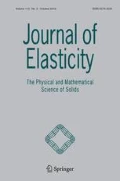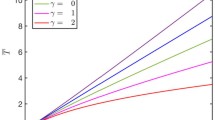Abstract
The paper illustrates a solution approach for the Saint-Venant flexure problem which preserves a pure objective tensor form, thus yielding, for sections of arbitrary geometry, representations of stress and displacement fields that exploit exclusively frame-independent quantities.
The implications of the availability of an objective solution to the shear warpage problem are discussed and supplemented by several analytical and numerical solutions.
The derivation of tensor expressions for the shear center and the shear flexibility tensor is also illustrated. Furthermore, a Cesaro-like integration procedure is provided whereby the derivation of a frame-independent representation of the displacements field for the shear loading case is systematically carried out via the use of Gibbs’ algebra.
The objective framework presented in this paper is further exploited in a companion article (Serpieri, in J. Elast. (2013)) to prove the coincidence of energetic and kinematic definitions of the shear flexibility tensor and of the shear principal axes.



Similar content being viewed by others
References
Baldacci, R.F.: Sull’integrazione diretta del problema di Saint-Venant in termini di tensioni. Atti R. Accad. Sci. Torino 90, 604–610 (1956)
Baldacci, F.: Soluzione generale diretta del problema di Saint-Venant. Giornale del Genio Civile 95, 759 (1957)
Banerjee, P.K., Butterfield, R.: Boundary Element Methods in Engineering Science. McGraw-Hill, New York (1980)
Beltrami, E.: Osservazioni sulla nota precedente. Atti Accad. Lincei Rend. 1(5), 141–142 (1892)
Benveniste, Y., Chen, T.: The Saint-Venant torsion of a circular bar consisting of a composite cylinder assemblage with cylindrically orthotropic constituents. Int. J. Solids Struct. 40(25), 7093–7107 (2003)
Bisegna, P.: The Saint-Venant problem for monoclinic piezoelectric cylinders. J. Appl. Math. Mech. 78(3), 147–165 (1999)
Borrelli, A., Patria, M.C.: Decay and other estimates for a semi-infinite magnetoelastic cylinder: Saint-Venant’s principle. Int. J. Non-Linear Mech. 32(6), 1087–1099 (1997)
Cesaro, E.: Sulle formule del Volterra, fondamentali nella teoria delle distorsioni elastiche. Rend. Accad. Sci. Fis. Mat. (Soc. Reale Napoli) 3a(12), 311–321 (1906)
Clebsch, A.: Theorie der Elasticität der fester Körper (1862). Leipzig
Cowper, G.R.: On the accuracy of Timoshenko beam theory. J. Appl. Mech. ASME 33(2), 335–340
De Saint Venant, A.B.: Mémoire sur la torsion des prismes. Mém. Savants éntrangers. Acad. Sci., Paris 14, 223–560 (1855)
Dong, S.B., Alpdogan, C., Taciroglu, E.: Much ado about shear correction factors in Timoshenko beam theory. Int. J. Solids Struct. 47(13), 1651–1665 (2010)
El Fatmi, R., Zenzri, H.: On the structural behavior and the Saint Venant solution in the exact beam theory. Application to laminated composite beams. Comput. Struct. 80, 1441–1456 (2002)
Gibbs, J., Wilson, E.: Vector Analysis. Yale University Press, New Haven (1901)
Gruttmann, F., Sauer, R., Wagner, W.: Shear correction factors in Timoshenko’s beam for arbitrary cross-sections. Comput. Mech. 27, 199–207 (2001)
Gurtin, M.E.: The linear theory of elasticity. In: Encyclopedia of Physics, vol. VIa/1. Springer, Berlin (1965)
Iesan, D.: On Saint-Venant’s problem. Arch. Ration. Mech. Anal. 91(4), 363–373 (1986)
Iesan, D.: On the theory of uniformly loaded cylinders. J. Elast. 16(4), 375–382 (1986)
Lacarbonara, W., Paolone, A.: On solution strategies to Saint-Venant problem. J. Comput. Appl. Math. 206, 473–497 (2007)
Ladevéze, P., Simmonds, J.: New concepts for linear beam theory with arbitrary geometry and loading. Eur. J. Mech. A, Solids 17(3), 311–402 (1998)
Love, E.: A Treatise on the Mathematical Theory of Elasticity. Dover, New York (1944)
Marsden, J.E., Hughes, T.J.R.: Mathematical Foundations of Elasticity. Dover, New York (1994)
Mason, Jr., Herrmann, L.R.: Elastic shear analysis of general prismatic beams. J. Eng. Mech. ASCE 94, 965–983
Michell, J.: On the direct determination of stress in an elastic solid, with applications to the theory of plates. Proc. Lond. Math. Soc. 31, 100–124 (1899)
Podio-Guidugli, P.: St.Venant formulae for generalized St.Venant problems. Arch. Ration. Mech. Anal. 81, 13–20 (1983)
Popescu, B., Hodges, D.H.: On asymptotically correct Timoshenko-like anisotropic beam theory. Int. J. Solids Struct. 37, 535–558 (2000)
Renton, J.D.: Generalized beam theory applied to shear stiffness. Int. J. Solids Struct. 27(15), 1955–1967 (1991)
Renton, J.D.: A note on the form of the shear coefficient. Int. J. Solids Struct. 34(14), 1681–1685 (1997)
Renton, J.D.: Check on the accuracy of Timoshenko’s beam theory. J. Sound Vib. 245(3), 559–561 (2001)
Sapountzakis, E.J., Mokos, V.G.: A BEM solution to transverse shear loading of beams. Comput. Mech. 36, 384–397 (1992)
Sapountzakis, E.J., Mokos, V.G.: A displacement solution to transverse shear loading of composite beams by BEM. Comput. Mater. Continua 10(1), 1–39 (2009)
Schramm, U., Kitis, L., Kang, W., Pilkey, W.D.: On the shear deformation coefficient in beam theory. Finite Elem. Anal. Des. 16, 141–162 (1994)
Serpieri, R.: On the equivalence of energetic and geometric shear factors based on Saint Venant flexure (2013) Companion paper. Submitted to J. Elast. alongside the present one
Sokolnikoff, I.S.: Mathematical Theory of Elasticity. McGraw-Hill, New York (1956)
Stephen, N.G.: On “A check on the accuracy of Timoshenko’s beam theory”. J. Sound Vib. 257(4), 809–812 (2002)
Synge, J.L.: The problem of Saint Venant for a cylinder with free sides. Q. Appl. Math. II, 307–317 (1945)
Timoshenko, S.P., Goodier, J.N.: Theory of Elasticity. McGraw-Hill, New York (1970)
Volovoi, V.V., Hodges, D.H., Berdichevsky, V.L., Sutyrin, V.G.: Asymptotic theory for static behavior of elastic anisotropic I-beams. Int. J. Solids Struct. 36, 1017–1043 (1999)
Zieniuk, E.: Potential problems with polygonal boundaries by a BEM with parametric linear functions. Eng. Anal. Bound. Elem. 25, 185–190 (2001)
Author information
Authors and Affiliations
Corresponding author
Appendices
Appendix A: Tensor Identities
We recall hereafter the definitions and tensor identities used throughout the paper.
1.1 A.1 Vector Product Between Vectors and Tensors
The operation of vector product between a vector a and a tensor T is defined as the unique tensor \(\mathbf{a\times T}\) that satisfies the property
for any vector b. On account of this definition one has componentwise
Setting T=I in (86) one obtains a relation between a skew-symmetric tensor W a =a×I and its axial vector a. In indicial notation the relation between W a and a is
In view of the properties recalled above, one also infers
and
Moreover, using the identity of double vector product,
one proves the relation
from which the following identities are inferred as special cases:
1.2 A.2 Gibbs’ Notation
The symbol ∇ was introduced by Gibbs [14] to denote a vector whose indicial expression is
in a Cartesian reference frame xyz. With the aid of vector ∇ it is possible to represent a large family of differential operators by means of binary operations in which ∇ is one of the operands. Actually, denoting by φ, v and S a scalar, a vector and a tensor field, respectively, one has
Similarly, the Laplacian Δc of a field c, either of scalar, vector or tensor type is expressed in Gibbs notation as Δc=(∇⋅∇)c while the Hessian of a scalar field φ is denoted as φ ∇⊗∇.
The main advantage of this notation consists in the faculty of inferring the differential identities commonly employed in elastostatics relying on the usual algebraic operations, i.e., treating ∇ as a common vector.
1.2.1 A.2.1 Product Rule
Let a, b and c be fields either of scalar, vectorial or tensor nature which are combined by means of an algebraic bilinear operation f,
Denoting by g, h, i, l and m bilinear operations such that the following relation is satisfied,
the following product derivation rule holds:
To show an application of (97), consider, for instance, the gradient of the vector field φ v,
This is the well known identity that in classical notation is written as
The differential identities exploited in this paper, and in particular those used in the derivation of the displacement field, can be all inferred from (97); in particular, denoting by φ, a and A a scalar, a vector and a tensor field, respectively, one has
Moreover, the following second order differential identities hold true:
Appendix B: Derivation of the Displacement Field Associated with the Flexure Problem for a Free Beam
This appendix provides the details of the integration procedure, based upon the differential identity (67), which allows one to derive the displacement field \({\mathbf{u}}^{(\mathit {DSV})}_{cant, \, free}\) starting from the infinitesimal strain field E cant, free associated, via the inverse of the linear elastic law, with the stress tensor field of formula (65). To achieve a simpler notation, in this appendix the scripts \(( \cdot)^{(\mathit{DSV})}_{cant, \, free}\) are henceforth omitted so that the stress and infinitesimal strain tensors are denoted by the symbols T and E in place of T cant, free and E cant, free .
Firstly, it is useful to express in an alternative from the shear stress field (40) by introducing the vector
whose gradient is the symmetric tensor
The vector p allows one to express A p as
so that the tangential stress field (40) becomes
The previous relation, upon introducing the vector ξ defined as
becomes
The stress tensor field is
Applying the linear isotropic law
to (108), we obtain the following representation for the infinitesimal strain field:
Substituting (107) into the previous expression and taking into account the relation \((1+\nu)\bar{\nu}=\nu\) one finally obtains
The explicit computation of the curl of E, i.e., ∇×E t, required by the previously outlined integration procedure, needs the separate computation of the curl of the addends contained in the RHS of the previous expression. Thus, we have
The identities above can be proved by invoking the differential identities reported in Appendix A.2.1 which, in turn, stem from the properties of the vector product (Appendix A.1).
Using the identities (112), the curl of E becomes
Because of identity (67), we now dispose of the expression of the gradient of ω; hence, to obtain ω, it is necessary to integrate the expression above. To this end (113) is further developed as
In particular, the last equality in (114) relies on the identity
which is inferred from the relation \(\hat{{\boldsymbol{\rho}}}={\mathbf{r}}- z{\mathbf{k}}\).
The rightmost expression in (114) allows one to directly identify the expression of the axial vector ω as
where ω 0 is an arbitrary constant vector field. Accordingly, the skew-symmetric component of the displacement gradient W, whose axial vector is ω, turns out to be
The last addend ω 0×I is the displacement gradient of an arbitrary rigid displacement field up to which the displacement field is defined. For the sake of brevity this term will be omitted in the following developments although it will be reported in the final expression of the displacement field.
Recalling identity (94) in Appendix A, one infers
By definition, the sum of the expression above with that of E reported in (111) provides the displacement gradient \(\mathrm{grad\,}\mathbf{u}={\mathbf{u}}\otimes \boldsymbol{\nabla}\). Comparing expressions (111) and (118) one recognizes the presence of two terms premultiplied either by the coefficient \(\frac{1+\nu}{E}\) or by \(\frac{\nu}{E}\). For the sake of readability, we introduce the representation
in the computation of the displacement gradient. In particular, the integral of \(\mathrm{grad\,}\mathbf{u}_{1+\nu}\) can be achieved more easily upon developing the integrand as follows:
Following an analogous strategy for \(\mathrm{grad\,}\mathbf{u}_{\nu}\) one has
Finally, adding all displacement terms and taking into account (106), the sought displacement field is given by
A significantly simpler expression is obtained by substituting (102) and (8) in (122) and is reported in (68).
Rights and permissions
About this article
Cite this article
Serpieri, R., Rosati, L. A Frame-Independent Solution to Saint-Venant’s Flexure Problem. J Elast 116, 161–187 (2014). https://doi.org/10.1007/s10659-013-9460-3
Received:
Published:
Issue Date:
DOI: https://doi.org/10.1007/s10659-013-9460-3
Keywords
- Saint-Venant solution
- Frame-independence
- Flexure problem
- Shear center
- Shear flexibility
- Boundary integrals




